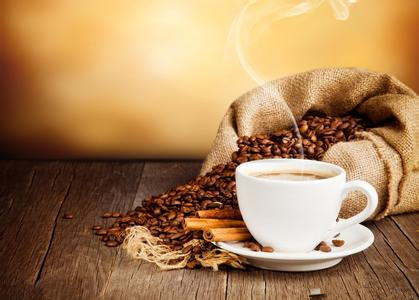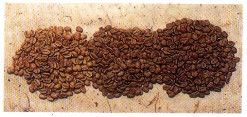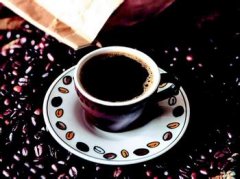A small, round, dark brown coffee bean.

Small and round dark brown coffee beans, quietly emitting a fragrant fragrance in the grinder, injected into the cup showing the beautiful color of amber, these are the three very deep impressions of coffee.
As you explore the history and beauty of coffee, you can also see the coffee trees that are caressed by the tropical sun and whose leaves twinkle. It has a small white flower similar to jasmine, its fruit from green to yellow-green, and finally to red, coffee beans are the seeds in its fruit.
Moreover, if you go to the coffee bean refinery, you will surely see the red pulp called coffee cherry and the fresh and green coffee raw beans with the endocarp and silver skin removed. These are the coffee beans for export.
At present, there are about 60 coffee-producing countries, most of which are located in areas with an elevation of 300 to 400 meters, and sometimes coffee trees are cultivated on highlands with elevations of 2000 to 2500 meters, but those planted on slopes above 1500 meters above sea level are said to be of better quality.
The most suitable conditions for the cultivation of coffee trees are areas with an average annual rainfall of 1500-2000 mm and an average temperature of about 20 degrees.
Coffee is an evergreen plant of the Akanaceae family. If it is wild, it can even grow to more than eight meters. However, in the farm, the height is cut to about two meters to ensure the quality of coffee beans and facilitate management.
At present, the main tree species planted are Arabica species, Robusta species (Carneva species) and Liberika species. It can be subdivided into dozens of varieties, which will be distinguished in production, circulation and trading.
Even in the same producing country, it will have a subtle influence on the flavor and quality of coffee beans and produce their own characteristics because of the differences in climate, altitude and soil quality in different regions. Therefore, according to the variety, origin, brand, there will be different attributes; therefore, it is impossible to describe the characteristics of a country's coffee beans in one sentence!
Specifications and grades of ◎ coffee beans
a. Washing / non-washing
Washing type: in the sink, after rubbing with water and utensils, the pulp and colloid are removed and dried, which is called washing coffee bean with uniform quality.
Non-washing type: after the sun is naturally dried, the pulp and peel is removed by a sheller, and its quality is unstable.
b. Flat beans / round beans
The fruit of coffee consists of two oval seeds opposite each other. The connecting side of each other is a flat joint, which is called flat bean. But there is also a round seed called a round bean, which tastes no different. Ripe and red coffee cherries have multiple structures. In the middle is the predecessor of the coffee bean, the light green seed.
Generally speaking, the fruit of coffee is made up of two oval seeds opposite each other. The side that connects with each other is a flat joint, so it is called flat bean. But some are made up of a round seed, and its taste is no different.
c. The size of coffee beans
Filter number (mesh no.) Coffee bean size
Pingdou 20-19 is very large.
18 big
17 quasi-big
16 ordinary
15
14 small
13-12 extra-small
The size of round bean is 13 to 12.
11 quasi-big
10 ordinary
9
8 small
d. Altitude
According to the elevation of the cultivated land, it can be divided into three, four, seven and other grades. Generally speaking, the quality of highland beans is better than that of lowland beans, and the price is higher because of the increase in freight.
Grade name elevation (m)
1 special grade beans 1.500 ~
2 first-class beans 1.200 and 1.500 ~
3 medium beans 1.000 and 1.200
4 special water washing beans 9001.000
5The beans are washed with good water 760mm 900.
6 special water washing beans 610-760
7 excellent water washed beans ~ 610
e. Quality
According to the statistical method, the type and quantity of dopants contained in a certain amount of samples are converted into percentage "defect number", and the basis for determining the quality class is that the smaller the defect number is, the higher the quality is.
f. Taste
Brazil, Haiti, Kenya, say and other countries all have their own taste testing methods, which can be exported only after taste testing.

New crop (new bean) luster is light green, with a unique sour taste and coffee aroma, very distinctive. (right)
Past crop (annual bean) has a yellowish color with a light green color, which is sour and milder than the new bean. (middle)
Old crop (multi-year bean) is yellow due to water loss, slightly sour and ordinary in taste. Usually used as a blend and brewed into canned coffee. (left)
Another way is to wash the fruit, in which the fruit to be harvested is put into a flowing trough. After the floating fruit is removed, the skin and flesh are removed by a pulp remover. Then put it in the sink to remove the emerging pulp. After that, move into the fermentation tank, soak for half a day to a day, and then dissolve the gum on the surface of the fermented coffee beans. After washing with water, drying it for a few days, drying it with a machine, and finally using a sheller to remove the endocarp to become a commercial raw coffee bean.
Water-washed coffee beans have more beautiful color and less impurities. Colombia, Mexico, Guatemala and other countries use this method for about 70% of their output.
Sometimes in the fermentation process, if not handled properly, it may give off fermentation odor and its unique sour taste, but if handled properly, all kinds of beans can give off their unique coffee aroma.
In order to be delivered completely to the destination, raw coffee beans are packed in sacks and placed in special containers for long-distance merchant shipping trips.
Important Notice :
前街咖啡 FrontStreet Coffee has moved to new addredd:
FrontStreet Coffee Address: 315,Donghua East Road,GuangZhou
Tel:020 38364473
- Prev

Basic knowledge of coffee producing countries distributed in global coffee planting bases
Brazil is the producer of coffee. All grades and types of coffee account for 1/3 of the world's consumption. There are many kinds of coffee here. Although there is not much superior coffee, it can be used to make mixed coffee with other coffee. The characteristics of the taste: mild, moderate bitterness, soft aroma. The best fried degree: the output of medium fried Colombian coffee is second only to Brazil.
- Next

What is a public bean? Male beans are deformities that occur during the growth of coffee beans.
Coffee beans can be divided into male and female? In fact, male beans are deformities that occur during the growth of coffee beans. In general, coffee beans have two pieces of beans, but there is only one piece of beans, which is also known as a single bean. A piece of beans absorbs more nutrients, and the color, shape and particles of coffee beans are relatively large. The fragrance of boiled coffee is constantly sweet, and the quantity is relatively small, so it is also known as Dream Coffee. Taiwan
Related
- Guji coffee producing area of Guji, Ethiopia: Humbela, Shakiso, Wulaga
- What is the most expensive variety of Qiloso in BOP multi-variety group?
- How to store the coffee beans bought home?
- Why are Yemeni coffee beans so rare now?
- Ethiopian Sidamo all Red Fruit Sun Sun Santa Vini Coffee beans
- SOE is mostly sour? What does it mean? Is it a single bean? what's the difference between it and Italian blending?
- Is Italian coffee beans suitable for making hand-brewed coffee?
- How to choose coffee beans when making cold coffee? What kind of coffee beans are suitable for making cold coffee?
- Just entered the pit to make coffee, what kind of coffee beans should be chosen?
- Can only Japan buy real Blue Mountain Coffee? What are authentic Jamaican Blue Mountain coffee beans?

